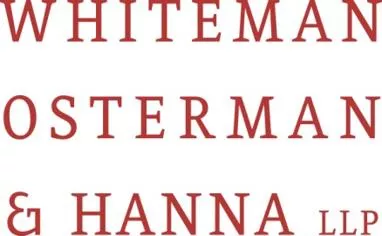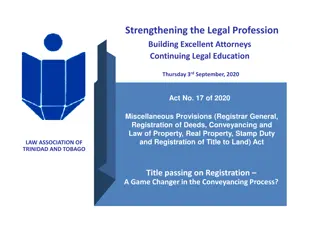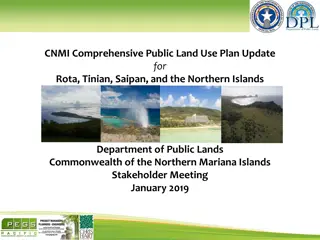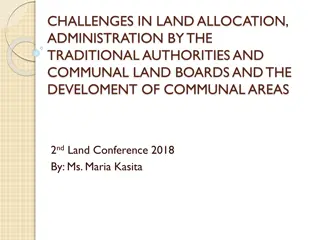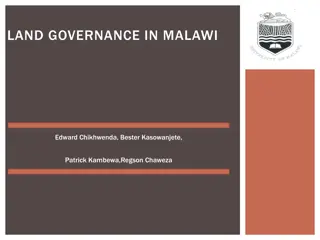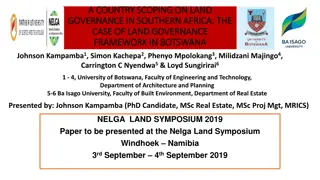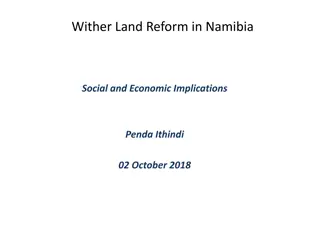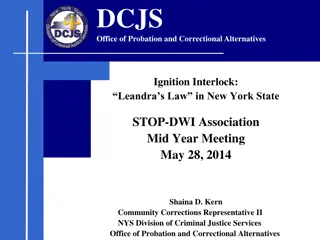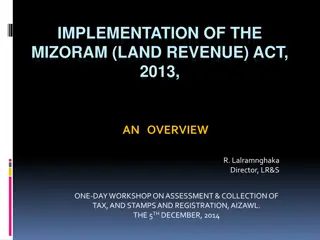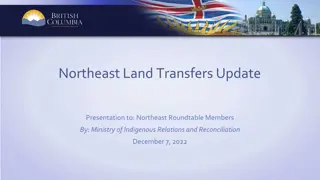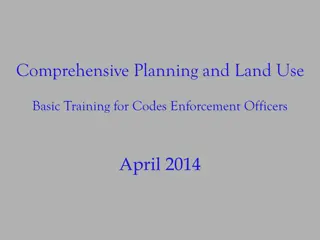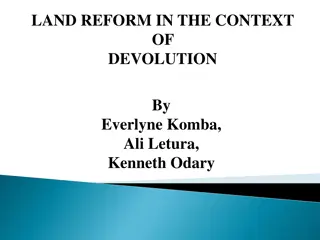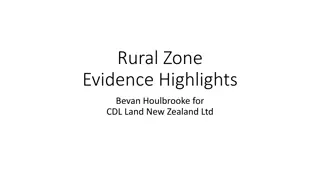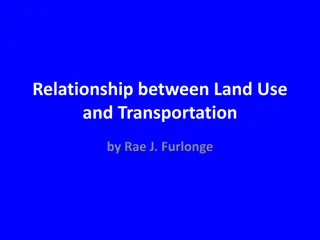Key New York Case Law Updates on SEQRA and Land Use
Pittsford Canalside Properties, LLC v. Village of Pittsford highlighted that once a decision is made under SEQRA regulations, Trustees lack authority to rescind it without substantive modifications to the project. On the other hand, Green Earth Farms Rockland, LLC v. Town of Haverstraw Planning Board showed the importance of further SEQRA review when significant changes are made to a site plan, even if the aggregate square footage remains similar.
Download Presentation

Please find below an Image/Link to download the presentation.
The content on the website is provided AS IS for your information and personal use only. It may not be sold, licensed, or shared on other websites without obtaining consent from the author. Download presentation by click this link. If you encounter any issues during the download, it is possible that the publisher has removed the file from their server.
E N D
Presentation Transcript
Land Use In New York Case Law Update Terresa M. Bakner One Commerce Plaza Albany, New York 12260 P 518.487.7600 F 581.487.7777 www.woh.com
SEQRA Pittsford Canalside Properties, LLC v. Village of Pittsford, 45 Misc.3d 1217(A), [Supreme Ct. Monroe Cnty. 2014] Facts Petitioner owned a certain 7.39-acre parcel in which it planned to develop a multiple dwelling building community Parcel was a petroleum contaminated strip of vacant land which would require expensive remediation process In 2009, petitioner submitted application for special permits to Village Board of Trustees From August 2009 to August 2012 the trustees conducted an environmental review of the project pursuant to SEQRA, which resulted in a negative declaration Following the election of incumbent mayor and two trustees, resolution was passed 3-2 to rescind the negative declaration Issue Can the Trustees rescind a negative declaration once it has approved the special permits and conceptual regulating plan?
Pittsford Canalside Properties, LLC, continued Discussion No, once that decision was made, the Trustees had no authority under SEQRA regulations to rescind the negative declaration and/or re-open its SEQRA review Further, the Court found that the decision to rescind the negative decision was not a result of any substantive modifications to the project, but rather because of community pressure directed against permitting Accordingly, the Court found the rescission to be arbitrary and impermissible, and annulled and vacated the resolution to rescind the negative decision
Green Earth Farms Rockland, LLC v. Town of Haverstraw Planning Board, 45 Misc.3d 1209(A) [Supreme Ct. Rockland Ctny. 2014] Facts Beginning in 2004, a proposed mixed-use residential and commercial development was proposed for a 53.3-acre site which included substantial and significant wetlands Over the following years, the project underwent multiple revisions and reviews by the Town of Haverstraw Planning Board These resulted in accepting the finding of a Final Supplement Environmental Impact Statement ( FSEIS ) in December 2009, in which the project would include 200-units of housing and multiple retail buildings, including a 1,500 SF deli/coffee shop One year later, after the project had been transferred to a new developer, an application for site plan approval was submitted to the Planning Board The plan had changed somewhat, including the change of the 1500 SF deli/coffee shop to a 7,000 SF convenience store/gas station, but the aggregate square footage remained relatively the same After reviewing the new plan, the Planning Board granted final site approval without requiring any additional SEQRA review of the changed site plan Issue Was it necessary for the Planning Board to conduct further SEQRA review with the changed site plan?
Green Earth Farms Rockland,LLC, continued Discussion The Court held that the change to a gasoline station would have its own environmental impacts, even though the total square footage of the plan was relatively unchanged Given this, the proposed action upon which the FSEIS was issued was no longer consistent with the project described in the FSEIS As a result, the Court found that the gas station in this environmentally sensitive site must be studied in a supplemental environmental impact statement Thus, the Court found the granting of the final site plan approval to be arbitrary and capricious, and annulled the final site plan approval
Beekman Delameter Properties, LLC v. Village of Rhinebeck Zoning Board of Appeals, 44 Misc.3d 1227(a) [Supreme Ct., Duchess Ctny. 2014] Facts Petitioner owned a restaurant and inn adjacent to the subject property, which was undergoing the approval process for a 50-room boutique hotel, restaurant, and spa The subject property had previously received a negative declaration from the Village Planning Board for use as a 36-unit residential facility Following issuance of the negative declaration, the developer of the subject property changed the site plan to the 50-unit boutique hotel plan The Planning Board then adopted the negative declaration for the earlier residential plan and granted site approval for the hotel plan Issue Should the Town Board have granted the site plan approvals without a new environmental review process pursuant to SEQRA? Discussion The Court held that the change in use of the property from residential uses to hotel uses was a significant modification that would require a new review of the environmental impact As such, the court ruled that the Planning Board did not comply with the procedural requirements of SEQRA and would be required to issue a determination of significance in relation to the new project or amend its previous negative declaration to denote the significant change to the project
Pickerell v. Town of Huntington, 45 Misc.3d 1208(A) [Supreme Ct., Suffolk Ctny. 2014] Facts Petitioner brought proceeding seeking annulment of Town Zoning Board s granting of a special use permit and area variance for a proposed demolition and construction project of a 7-eleven convenience store In submitting its application for a special use permit and area variance, 7-Eleven failed to classify the project as a Type I action in Part I of the Environmental Assessment Form ( EAF ) which would likely require a formal environmental review of the project, due to its proximity to the National Register of Historic Places The Zoning Board failed to amend Part I of the EAF or consider adverse environmental impacts in Parts II and III of the Full EAF Nonetheless, the Zoning Board voted in favor of issuing a negative declaration Issue Did the Zoning Board meet the procedural SEQRA obligations imposed on a lead agency?
Validity of Local Action Pickerell, continued Discussion The Court found that the Zoning Board failed to promptly make its own preliminary classification of the proposed demolition and construction project as a Type I, Type II, or Unlisted action, and failed to verify the accuracy of the information provided in the EAF It also failed to have 7-Eleven, the project sponsor, properly complete Part I of the full EAF, and failed to present a full EAF to the Planning Commission Furthermore, as the Type I designation for the proposed project was made after the public hearing had been closed, the Zoning Board improperly cut off the public s opportunity to participate in the SEQRA process in a meaningful way Also, because Parts II and III of the EAF were completed after its determination, the Zoning Board did not give due consideration to all potential environmental impacts, not did it explain in detail the reasons for its determination that no significant adverse environmental impacts would result from the project As a result, the court annulled the determination of the Zoning Board
Cassara Properties, LLC v. Town of Greece, Index No. 2014/03346 [Supreme Ct. Monroe Ctny. 2015] Facts Petitioner Cassara Properties, LLC brought an Article 78 proceeding against the Town Board of the Town of Greece challenging the Town Board s SEQRA determination granting a special use permit to Full Road Management Corporation ( Fuller ) for use of Fuller s property as a photovoltaic cell manufacturing facility Cassara also contended that the Town Board violated the Open Meetings Law because copies of resolutions passed by the Town Board were not distributed prior to the public meeting in which the resolutions were passed Issues Did the Town Board violate the Open Meetings Law? Did Cassara have standing to commence a lawsuit seeking to overturn the SEQRA review? Was the town s SEQRA determination valid? Discussion The Court held there was no violation of the Open Meetings Law, as the resolutions were completed shortly before the public meeting and Cassara s counsel, who was present at the meeting, failed to make any request for copies of the resolutions at or prior to the public meeting Further, the Court found the Open Meetings Law leaves it to the discretion of the Town Board to determine if it is practicable to produce the proposed resolutions prior to or at the meeting The Court also found that Cassara had standing, because it was in the zone of interest to be protected by the zoning ordinance, as it s property was within 150 of the portion of the proposed facility that would contain hazardous materials
Cassara Properties, LLC, continued As for the challenge to the Town Board s SEQRA determination, the Court held that the Town Board identified the relevant areas of environmental concern, took a hard look at them, and made a reasoned elaboration of the basis for its determination Regarding the challenge to the special use permit, the court found that the Town Board considered all relevant evidence submitted, made a number of separate findings, incorporated many of those findings within the resolution, and granted the special use permit, subject to additional conditions The court also noted that the Town Board considered the prior industrial use of the proposed facility, a use which involved the use of potentially dangerous chemicals and existed prior to Cassara s ownership of their property Based on the Town Board s review process, considerations, and imposed conditions on the special use permit, the court concluded that the Town Board s determinations were reasonable
Troy Sand & Gravel Co. Inc. v. Town of Nassau, 2015 WL 685960, --- N.Y.S.2d --- , [3d Dept. 2015] Facts Plaintiff applied for a mining permit from the Department of Environmental Conservation ( DEC ) to operate a quarry in the Town of Nassau, and applied for a special use permit and site plan approval from Defendant Town of Nassau County DEC issued a positive declaration and Troy prepared a draft environmental impact statement ( EIS ) After a public comment period, Troy prepared a final EIS and DEC subsequently issued its SEQRA findings approving the project and granting the mining permit The Town then challenged the DEC s determination in a related Article 78 proceeding, and Troy brought this suit seeking a declaration that the town is bound by the DEC s SEQRA findings Issues Is the Town bound its own SEQRA findings? Is the Town permitted to conduct its own review of the environmental impact as part of its zoning determination? Discussion The Court held that while the Town is bound the DEC s SEQRA findings and it may not repeat the SEQRA process, the Town nevertheless retains the authority to make an independent review of Troy s application for a special use permit in accord with the standards and criteria set forth in the Town s applicable zoning regulations
Troy Sand & Gravel Co. Inc., continued That said, the Town s independent review does not include the ability to gather additional environmental impact information beyond the full SEQRA record Rather, in conducting its own jurisdictional review of the environmental impact of the project, the Town is required by the overall policy goals of SEQRA and the specific regulations governing finds made by involved agencies to rely on the fully developed SEQRA record in making the findings that will provide a rationale for its zoning determinations In a related Article 78 proceeding challenging the Town s additional review process, Troy appealed the dismissal of the petition on ripeness grounds The Court held that an additional review process by the Town did not impose an obligation, deny a right or fix some legal relationship as a consummation of the administrative process, elements which are required for a petitioner to have standing in an Article 78 proceeding Rather, any harm to Troy at that stage of the administrative process was merely speculative, and may be ameliorated by further proceedings Accordingly, the Town s decision to conduct an additional review was not ripe for judicial review
County of Rockland v Town of Clarkstown, 128 A.D.3d 957 [2d Dept. 2015] Facts Respondent, in an effort to address complaints concerning traffic and speeding on a Town road, authorized the placement of a temporary barrier near the intersection of the Town road and a village road owned by the Village of Chesnut Ridge( the Village ) This temporary barrier effectively turned the village road into a dead-end The resolution also directed the Town Police Department to conduct traffic studies to determine the effect of the barrier on local traffic The County of Rockland brought an Article 78 proceeding to annul the resolution passed by the town, which the Supreme Court denied The County then appealed Issues Did the temporary barrier interfere with or destroy the prior use of the village road? Was the Town required to undertake a SEQRA review prior to directing the Police to conduct the traffic study? Was the Town s adoption of the resolution arbitrary and capricious?
County of Rockland, continued Discussion The Appellate Division affirmed the Supreme Court s ruling The Court held that the barrier did not interfere with or destroy the prior public use of the Village road, and accordingly, the doctrine of prior public use, which prohibits towns from acquiring rights in property already devoted to another public use, where the acquisition will interfere with or destroy the prior public use, is inapplicable The Court also held that the Town was not required to undertake a SEQRA review prior to directing the Police to conduct the traffic study Finally the Court found that based on the record, the Town s adoption of the resolution was not arbitrary and capricious In a companion decision, the Appellate Department further held that the Town was not required to undergo a SEQRA review process prior to authorizing the installation of the temporary barrier The Court found that in approving the resolution, the Town had issued a negative declaration under SEQRA and had taken the requisite hard look at the environmental impact which would result from the installation of the barrier Accordingly, the Town s determination had a reasoned elaboration and was upheld by the Court
Wilmorite Inc. v. Planning Board of the Town of New Paltz, Index No. 14-1896, [Supreme Ct. Ulster Ctny. 2015] Facts Petitioner brought an Article 78 proceeding against the Respondent Planning Board over its refusal to grant site plan approval for Wilmorite s development known as Park Point, which would consist of some 696 student beds and an additional 30 dwelling units for faculty and staff of SUNY New Paltz The Planning Board issued a positive declaration for the project after it undertook a review of the environment impacts of the project pursuant to SEQRA While undergoing SEQRA review, Wilmorite also negotiated a payment in lieu of taxes agreement (PILOT) with the County IDA At the conclusion of the SEQRA review process, Planning Board denied approval due to the PILOT Agreement Issue Was the Planning Board s determination, denying approval due to the PILOT agreement, valid? Discussion The Court upheld the Planning Board s determination, holding that the SEQRA review process seeks to strike a balance between social and economic goals and concerns about the environment by requiring an agency to engage in a balancing analysis in every instance Here, the Planning Board took the requisite hard look at the proposed project, and reasonably determined that the PILOT would result in significant adverse impacts upon community services that could not be mitigated, including that local services may actually decrease in part, because of the PILOT
Residents for Reasonable Development v. City of New York, 128 A.D.3d 609, [1st Dept. 2015] Facts Petitioner brought an Article 78 proceeding against Respondent City challenging the City s approval of the proposed facility expansion of the clinical arm of Memorial Sloan-Kettering Cancer Center ( MSK ) and the City University of New York ( CUNY ) Issue Was the City s approval of the proposed expansion valid? Discussion The Court dismissed the proceeding, holding that the City took the requisite hard look at the relevant areas of environmental concern, in particular the project s anticipated adverse environmental impacts, and provided a reasoned elaboration of the basis of their approval of the project The Court further held that MSK s development and construction of a garage facility 50 blocks from the main project site was independent from the expansion project and the FEIS was not required to consider the potential environmental impacts of the garage Additionally, the Court held that the City was not required to consider RRD s preferred alternative scenario, and that the City s rezoning of the parcel did not constitute illegal spot zoning or ad hoc legislation
Variances & Special Use Permits Cunney v. Board of Trustees of the Village of Grand View, 2014 WL 5025957,---F.Supp.3d- -- [S.D.N.Y. 2014] Facts Plaintiff owned a certain piece of real property in the Village of Grand View on the Hudson, on the easterly side of River Road between the Road and the Hudson River The Village Zoning law provided a certain Section E which contained a height restriction on the height of any building constructed within the subject parcel s zoning district In pertinent part, Section E provided that the roof line shall rise no more than four and one-half feet above the easterly side of River Road The Village Zoning law also provided the procedure for which to build and occupy a house, which included getting site plan approval, a public hearing, and submission of other relevant documents related to the construction of the dwelling After construction was completed, but before receiving a Certificate of Occupancy ( CO ), the Building Inspector was required to inspect the building and determine whether the construction had been completed in accordance to plan approved Cunney sough approval of a site plan in early 2006 for the construction of two-story Home and relocation of a small home that would be used as a pool house The height of the Home was to be 43.7 feet, which would require Cunney to receive a height variance Cunney s application for a variance was denied, and a revised site plan was then brought in September 2006 The revised site plan did not require the granting of any height variance and it was eventually approved by the Planning Board Pursuant to the Planning Board s site plan approval, the Building Inspector approved Cunney s building height
Cunney, continued Upon completion of the Home in September 2007, Cunney submitted an application for a CO The Building Inspector found that there were mistakes in the elevations used by Cunney in the original site plan, which resulted in a two-foot discrepancy between the site plan elevations and the real world elevation, such that the allowable height was two feet lower than expected Thus, the building inspector denied Cunney s CO application Cunney appealed this determination and the Zoning Board of Appeals granted a height variance in return for Cunney s removal of the pool house and the maintenance of an obstructed river view from River Road Cunney ultimately did not comply with the conditions of the grant of a variance and filed an action challenging the denial of his CO application Issues Was Section E unconstitutionally vague on its face and as applied to him? Did the village deprive him of substantive due process? Discussion The Second Circuit held that Section E was unconstitutionally vague as applied to Conney because it failed to give specific notice of how a permit applicant should design his site plan so that a proposed building complies with that restriction, and Section E failed to provide an objective standard that the Village could apply in determining the project s compliance once an application has been submitted and thereafter when an approved project has been built Further, Section E could encourage potentially arbitrary and/or ad hoc enforcement and, as applied to the design and construction of the Home, could not be saved by resort to a clear core because, under a reasonable interpretation of the ordinance, the Home, as built, does not comply with Section E
Cunney, continued The Second Circuit remanded Cunney s substantive due process back to the district court, instructing the court that the Home s failure to comply with Section E was not a basis for denying Cunney the CO because Section E was unconstitutionally vague On remand, the district court held that Cunney s substantive due process rights were not violated by the denying of the CO, as the Village Law gave the Building Inspector the discretion to make a determination of conformity or non-conformity to the approved plans and regulations The court found that the discretion granted to the building inspector defeated any protected property interest Cunney may have had in the CO, as the issuance of the CO was dependent on the Building Inspector s determination of compliance The court also held that Cunney had no vested right to the CO based on investments he made in reliance on his belief that he would obtain a CO
Sunrise Detox V, LLC v. City of White Plains, 769 F.3d 118, [2d Cir. 2014] Facts Plaintiff applied for a special use permit under the zoning ordinance of White Plains, New York, to establish a facility for individuals recovering from drug or alcohol addiction, and because of zoning regulations sought to have its proposed facility designated as a community residence The commissioner of the City Department of Building determined that the facility did not qualify as a community residence and that, as a result, the City could take no further action on the application until Sunrise either applied for a variance or appealed the determination Instead, Sunrise brought this action alleging intentional discrimination, disparate impact discrimination, and failure to grant a reasonable accommodation in violation of the Americans with Disabilities Act ( ADA ) Issue Were Sunrise s claims ripe for adjudication even though they presented a zoning dispute as to which there had been no final determination? Discussion The district court dismissed the claims for lack of subject matter jurisdiction and the claims being unripe On appeal, the Second Circuit upheld the district court s decision
Sunrise Detox V, LLC, continued The Second Circuit held that landowners bringing zoning challenges must meet the high burden of proving that the court can look to a final, definitive position from a local authority to assess precisely how they can use their property before the court may entertain their claims The Court noted that because Sunrise sought an injunction blocking the disapproval of the application and authorizing the construction of this project, the case must go through the administrative review process to a final determination before it is ripe for judicial review Furthermore, the Second Circuit held that by Sunrise failing to comply with the final- decision requirement, it inhibited the kind of give and take negotiation that often resolves land use problems, removed the opportunity from the City to accommodate Sunrise through the City s established procedures used to adjust the housing and zoning rules and policies in question, and prevented the court from determining whether the City had made clear that all such actions would be denied thus showing that application for a variance would be futile Thus, because Sunrise did not meet the final-decision requirement, the Second Circuit held that the case was not yet ripe
Zoning & Interpretation Waterways Development Corp. v. Town of Brookhaven Zoning Board of Appeals, 5 N.Y.S.3d 450 [2d Dept. 2015] Facts Property owners initiated an Article 78 proceeding, seeking to review a determination of the town s Zoning Board of Appeals ( ZBA ), which denied owners application for a determination that previously approved height variances for a planned retirement community project remained valid Petitioner owned approximately 100 acres of property in the respondent Town of Brookhaven, which was developed with a planned retirement community This property had been previously owned by Bay Pointe Associates, which sought to construct a retirement community with more than 500 dwelling units in the 1980s Bay Pointe applied to the ZBA for variances to permit the construction of three buildings having three stories not exceeding 35 ft., instead of two and one-half stories not exceeding 35 ft., as was previously permitted by the Town Code These variances were granted for one year, and a one year extension was thereafter given, with the notion that the project would take six years to complete Bay Pointe requested a rehearing on the extension, and the ZBA granted a further extension of the variances, with the variance approval stating , Granted, respectively, due to magnitude of project, approved for life of job Bay Pointe completed the construction of approximately 228 units, but went into bankruptcy in 1995 and the premises were sold to Post Village, Inc. After the Commissioner of the Planning Board responded to an inquiry from Waterways stating that the remainder of the units could still be built, Waterways purchased the premises and completed further construction, leaving only the three buildings having three stories not exceeding 35ft. to be built In May 2001, Waterways applied for building permits and was denied, and then appealed to the ZBA, who denied the application for a determination that the variances were still valid
Waterways Development Corp., continued Issue Were the ZBA s determinations denying that the variances were still valid arbitrary and capricious where the variance approval stated that they would be valid for the life of the job? Discussion The Second Department held that the ZBA s determination that the 1986 variances were no longer valid was arbitrary and capricious, based on the plain language of the variance approval which stated that the variances were approved for life of job Further, the Court found that respondent s reliance on estimates of the construction time-table given at a public hearing in 1986 effectively and improperly imposed a condition not stated in the variance approval The Court also found that the Supreme Court had properly remitted the matter to the Town for the issuance of building permits sought by Petitioner, as once a variance has been granted, the Town is obligated to issue the building permits as a ministerial act
Frigault v. Town of Richfield Planning Board, --- N.Y.S.3d ---, N.Y. Slip. Op. 04355, [3d Dept. 2015] Facts Respondent Monticello Hills Wind, LLC sought a special use permit in connection with the proposed construction of six wind turbines and related facilities on the land located in the Town of Richfield, Ostego County The respondent Town of Richfield Planning Board granted this permit in 2011 The Supreme Court annulled both determinations in an Article 78 proceeding and action for declaratory judgment that followed The Third Department upheld the annulment of the special use permit on appeal, agreeing that the Board had failed to comply with the applicable Town Land Use and Building Management Ordinance, which only allows the issuance of a special permit where eight enumerated conditions are met After this, the Board corrected the procedural deficiencies that were present before, and in September 2013, issued a special use permit accompanied by detailed findings regarding the eight conditions set forth by the Land Use Ordinance Petitioners then commenced this Article 78 proceeding
Frigault, continued Issue Discussion Did substantial evidence support the Board s findings as to the conditions being met? The Supreme Court agreed with the Petitioners that substantial evidence did not support the Board s findings with regard to two of the conditions, granted their petition and annulled the special use permit, which the Respondents then appealed The Third Department found that the Land Use Ordinance specified uses in the area where the project was to be built, and allows for all other uses for which a special use permit is obtained Therefore, the court said the determination of the Board that those conditions had been met in this case would be upheld if it has a rational basis and is supported by substantial evidence in the record The Court agreed with the lower court that the Board s findings were supported by substantial evidence with regard to six of the eight conditions With regard to the other two conditions, the Board found that there was substantial evidence even where the lower court had pointed to conflicting evidence submitted by the petitioners with regard to both conditions The Court stated that a court cannot substitute its own judgment where substantial evidence supports the determination of the Board Therefore, the Court found that the Supreme Court erred in annulling the special use permit
Concerned Citizens of Wainscott v. Planning Board of Town of East Hampton v. Zoning Board of Town of East Hampton, --- N.Y.S.3d ---, 2015 WL 3480252, [2d Dept. 2015] Facts In June 2011, Wainscott Wombles, LLC ( Respondent ) purchased the property at issue in Wainscott, New York The property is located in a residential zoning district, but before 1976 the sole building of the property had a pre-existing nonconforming use as a diner In 1975, the Zoning Board of the Town of East Hampton approved the application of the then-owner of the property to change the nonconforming use from the diner to a real estate office and antique shop In June 2011, when Respondent bought the property, the Town of East Hampton building inspector determined that Respondent could construct a single-family home on the property, in addition to the nonconforming use, pursuant to the Town Code In February 2012, the Planning Board of the Town of East Hampton approved an application by Respondent to construct a separate 600 SF single-family residence on the premises in addition to the existing commercial building In June 2012, the Zoning Board of Appeals upheld the Building Inspection s determination Petitioner then commenced this action to review the determinations of the Zoning Board of Appeals and the Planning Board
Concerned Citizens of Wainscott, continued Issue Were the determinations of the Zoning Board of Appeals and Planning Board arbitrary and capricious? Discussion The Supreme Court denied the petitions, and in effect, dismissed the proceedings The Second Department fond that the Town Code defined commercial property in relevant part, as any lot containing a nonconforming business use and permits any one commercial property in any district to have two uses Thus, the Court found that the Town Code permitted the construction of a single-family residence in addition to the existing non-conforming business use, and the Zoning Board of Appeals and Planning Board s determinations to approve the application of the LLC to build the single family residence were not arbitrary and capricious
Boni Enterprises, LLC v. Zoning Board of Appeals of the Town of Clifton Park, Index No. 518906 (3d Dept. 2015) Facts Petitioners Boni Enterprises, LLC brought an Article 78 proceeding against Respondent Zoning Board of Appeals ( ZBA ) over interpretation of the Town Code s zoning provisions in relation to Boni s site plan to build 74 one-family dwellings on parcel and 15 commercial buildings on a second parcel The ZBA interpreted the Town Code as preventing Boni s site plan to build multiple one-family dwellings on one parcel Issue Did the Town Code prevent the building of multiple one-family dwellings on one parcel? Discussion The Court reversed the ZBA s determination, holding that a town s zoning ordinance and any ambiguity must be resolved in favor of the property owners The relevant portion of the Town Code allowed multiple buildings on a lot. . . as long as the overall density limitations of this article are not exceeded The ZBA did not dispute that Boni s proposal would comply with the density limitations, but argued that a dwelling was different than a building, and accordingly multiple dwellings are not permitted The Court disagreed, holding that a dwelling clearly falls within the definition of a building under the Town Code The plain language of the Town Code, strictly construed against the Town, must be interpreted as permitting multiple buildings, including one-family dwellings, on a single lot as long as they do not exceed the density limitations
Procedural Issues Sierra Club v. Village of Painted Post, 2014 WL 1258269, --- N.Y.S.2d ---, [App. Div. 2013] Facts Petitioner brought proceeding against Village of Painted Post regarding the authorization of the sale and export of excess water from the municipal water supply, which included the construction of a transloading facility to load the water onto trains that would then transport the water to a buyer in Pennsylvania The trains that transported the water used an existing rail line that runs through the entire Village Petitioner Marvin contended that the noise as a result of the trains caused him injury Issue Did Marvin have standing to bring this claim? Discussion The Supreme Court held that Marvin had standing because he had an injury in fact The Appellate Division overturned, holding that Marvin did not sustain an injury that was different from that of the public at large, and that standing could not be based on the claim that a project would indirectly affect noise levels throughout a wide area Because the individual petitioners could not allege a unique, different environmental injury, none of the organizational petitioners could be found to have standing
Citizens for St. Patricks v. City of Watervliet City Council, 2015 WL 1057857, --N.Y.S.3d--, [3d Dept. 2015] Facts Plaintiffs, consisting of a number of individuals and Citizens for St. Patrick s, an incorporated advocacy group, sued the City of Watervliet City Council and Nigro Companies, challenging the negative declaration issued by the City and the City s rezoning of a certain property owned by Nigro Companies Under this proposal, Nigro would demolish a former catholic church and redevelop the parcel into a grocery store and retail center In a prior Article 78 proceeding, Plaintiffs had succeeded in receiving a temporary restraining order from the Court preventing Nigro from commencing demolition However as part of that proceeding, Plaintiffs were denied a preliminary injunction, which would have prevented demolition of the church Plaintiffs then failed to perfect their appeal in that proceeding and Nigro redeveloped the parcel Issues Do the Plaintiffs have standing to commence an action against Nigro? Are the Plaintiffs challenges moot because they did not seek any injunctive relief from the Court during the pendency of the appeal? Discussion The Court held that none of the Plaintiffs had standing except for two, who lived directly across the street from the parcel and would suffer direct harm different from the general public Nevertheless, the Court found all of Plaintiff s challenges moot, because they did not seek any injunctive relief from the court during the pendency of the appeal and the church had now already been demolished The Court also found the challenge to the rezoning determination to be moot, as the City had adopted a new zoning code in which Nigro s use of the parcel was permitted as of right, and Plaintiffs did not raise any challenge to that code
Rural Community Coalition Inc. v. Village of Bloomingburg, Index No. 519346, [3d Dept. 2015], leave to appeal denied Mo. No. 2015-570 [N.Y. 2015] Facts Developer, Black Creek Development ( Black Creek ) began seeking approval for a townhome project in 2006 As part of the project, a portion of the property located in the Town of Mamakating ( the Town ), Sullivan County was annexed in 2006 by local law of the Village of Bloomingburg ( the Village ) Construction began on the project in 2012, with the support of both municipalities Thereafter, Rural Community Coalition ( RCC ) brought this action against the Town, Village, and Black Creek, alleging the annexation was void In 2014, after a new Town Supervisor and Mayor had been elected, both the Town and the Village reversed their position and declared that the annexation was void Issue Was the challenge to the local law untimely? Discussion The Supreme Court held for the RCC, declaring the annexation void, and Black Creek appealed The Appellate Division held for Black Creek, holding that the challenge to the local law was untimely, as the current action was commenced more than seven years after the annexation and nearly six years after the Court of Appeals decision clarifying the law The Court found that the crux of the action was the Town and Village regretting the granting of the development approvals, which were given well after the annexation at issue As such, the action was barred by the statute of limitations
Due Process & Equal Protection Acquest Wehrle, LLC v. Town of Amherst, --- N.Y.3d ---, 2015 WL 379670, [4th Dept. 2015] Facts Defendant Town of Amherst Town Board entered into an agreement with the U.S. Environmental Protection Agency ( EPA ) in which the EPA and the Town agreed to prohibit for 50 years new development located in identified wetlands from connecting to sewers funded in part by a 5.6 million dollar grant from the EPA Plaintiff owned a property which was located partially in a designated wetland Plaintiff proposed to develop the property into an office park, and after a full SEQRA review the property was rezoned to permit the proposed use The Town Board then authorized a request for a sewer tap-in waiver from the EPA for the property, and Plaintiff applied for such a waiver from the EPA The EPA denied the waiver request, leaving Plaintiff to revise its site plan Upon reapplication for a waiver, the EPA notified Plaintiff that based upon the revised site plan and issuance of a permit, a tap-in-waiver would be approved After the permit was issued to Plaintiff, but before the final approval of the revised site plan by the Planning Board, the Town Board, without any notice, passed a resolution rescinding the tap-in- waiver request and terminated the office park project Plaintiff then commenced a federal action against the Town Board Issue Was the Town Board s rescinding of the tap-in-waiver a deprivation of Plaintiff s substantive due process and equal protection rights?
Acquest Wehrle, LLC, continued Discussion The trial court found that the Town Board violated Plaintiff s due process and equal protection rights, awarding them 1,459,411 dollars and 1,588,000 dollars, respectively The Town Board appealed, and the Appellate Department upheld the trial court s determination that the Town Board violated Plaintiff s due process rights The Court found that Plaintiff had a constitutionally protectable property interest in the sewer tap-in- waiver request by the Town Board on behalf of Plaintiff, and that the Town Board had no further discretion to exercise after the EPA advised Plaintiff that the revised site plan would form the basis of an acceptable waiver request The Court also found that the Town Board s rescinding of the tap-in-waiver request was wholly without legal justification The manner in which the Town Board met, without notice to Plaintiff and only six days after Plaintiff received their permit, coupled with the Town Board s action, failing to consider the SEQRA documents and terminating the project rather than simply withdrawing the tap-in-waiver, was sufficient evidence to prove that the Town Board s conduct was solely politically motivated and without legal justification However, the Court reversed the trial court s determination that Plaintiff s right to equal protection was violated, as Plaintiff failed to show its property was similarly situated to two other properties that had been approved for development
Chabad Lubavitch of Litchfield County Inc. v. Litchfield Historic District Commission, 786 F.3d 183 [2d Cir. 2014]. Facts Chabad, a religious organization offering weekly religious and other services to its Orthodox Hasidic parishioners, purchased certain real property in the historic residential district of Litchfield, known as the Deming House , which is a 2,600 SF former Victorian residence constructed in 1870 and since altered to accommodate a commercial establishment Chabad purchased the property with the intention of constructing a 17,000 SF addition which would include administrative offices, classrooms, a 5,000 SF residence for the rabbi, an indoor swimming pool, and a clock tower featuring the Star of David In September 2007, Chabad presented its proposed addition to Defendant Litchfield Historic District Commission ( HDC ), in which members of HDC voiced their opposition to the application Following a December 2007 meeting in which HDC considered whether denial of the application would place a substantial burden on its religious exercise, HDC denied Chabad s application, but granted accommodations as a substitute for the rejected modifications Chabad filed an action in September 2009 without seeking administrative appeal of the denial alleging that HDC s denial of their application abridged their rights under the Religious Land Use and Institutionalized Person s Act (RLUIPA) substantial burden, equal terms, and nondiscrimination provisions
Chabad Lubavitch of Litchfield County Inc., continued Issues Was Chabad sfailure to cite a valid secular comparator fatal to its claim under RLUIPA s equal terms provision? Did Chabad s failure to identify a religious institution that was more favorably treated and identically situated to Chabad preclude its claim under RLUIPA s nondiscrimination provision? Discussion The Second Circuit found that while the mere application of a neutral and generally applicable zoning law likely would not trigger RLUIPA, application of a zoning law that permits a governmental entity to consider the applicant s intended use of a property for religious uses, applying at least partly subjective criteria on a case-by-case basis likely would In applying this, the Second Circuit found that 7-147d(a) allowed HDC to apply loosely defined and subjective standards to Chabad s application, which is an individualized assessment under RLUIPA, and triggers the substantial burden provision of RLUIPA The Second Circuit remanded this claim back to the district court, instructing the court to consider in its substantial burden analysis whether the conditions attendant to HDC s denial of Chabad s application themselves imposed a substantial burden on Chabad s religious exercise, whether a feasible alternative existed for Chabad to exercise its faith, whether Chabad reasonably believed it would be permitted to undertake its proposed modifications when it purchased the Deming House, and whether the proposed modifications shared a close nexus with and would be consistent with accomodating Chabad s religious exercise
Chabad Lubavitch of Litchfield County Inc., continued The Second Circuit also remanded Chabad s RLUIPA nondiscrimination claim back to the district court for reconsideration In analyzing RLUIPA s nondiscrimination provision, the Second Circuit applied equal protection precedent, thus requiring Chabad to show proof of a discriminatory intent on the face of the law itself, in the adoption of the law, or in the enforcement of the law In reviewing the district court s decision, the Second Circuit found that the district court bypassed consideration of circumstantial evidence that might have supported Chabad s claim and instead considered only Chabad s cited comparators By limiting this analysis only to identical comparators, the requirement would be unduly restrictive Rather, the Second Circuit instructed the district court on remand to consider such factors as the series of events leading up to a land use decision, the context in which the decision was made, whether the decision or decision-making process departed from established norms, statements made by the decision-making body and community members, reports issued by the decision- making body, whether a discriminatory impact was foreseeable, and whether less discriminatory avenues were available.
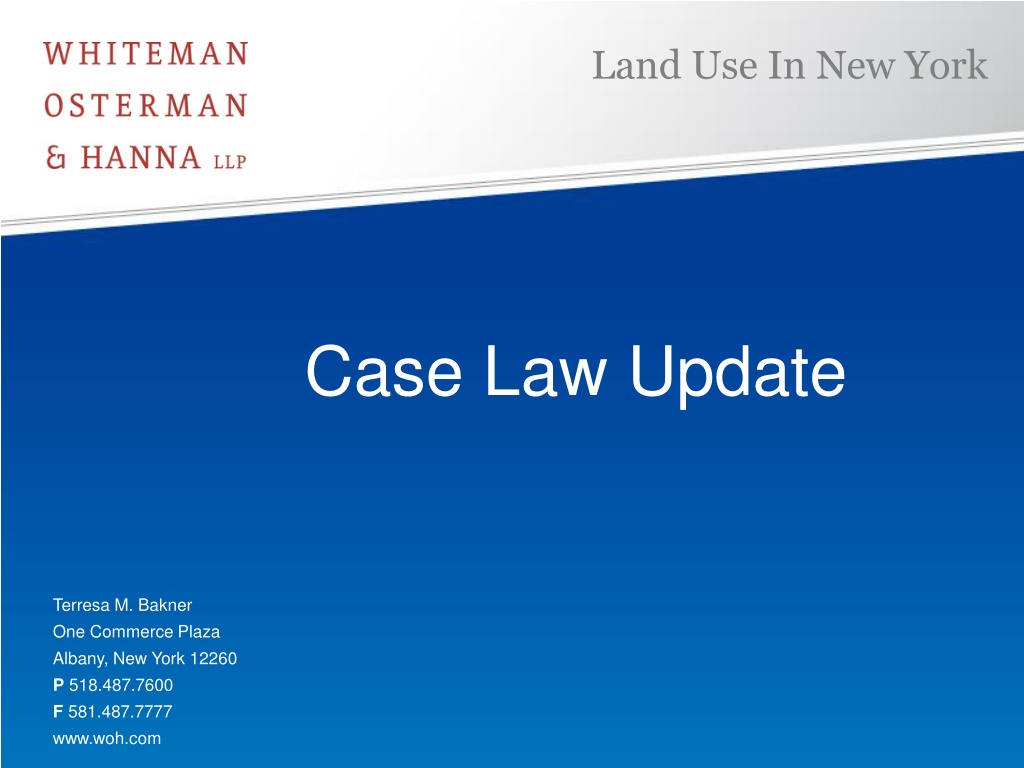
 undefined
undefined
